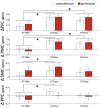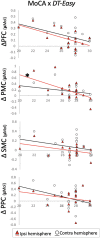Frontal, Sensorimotor, and Posterior Parietal Regions Are Involved in Dual-Task Walking After Stroke
- PMID: 35812105
- PMCID: PMC9256933
- DOI: 10.3389/fneur.2022.904145
Frontal, Sensorimotor, and Posterior Parietal Regions Are Involved in Dual-Task Walking After Stroke
Abstract
Background: Walking within the community requires the ability to walk while simultaneously completing other tasks. After a stroke, completing an additional task while walking is significantly impaired, and it is unclear how the functional activity of the brain may impact this.
Methods: Twenty individual in the chronic stage post-stroke participated in this study. Functional near-infrared spectroscopy (fNIRS) was used to measure prefrontal, pre-motor, sensorimotor, and posterior parietal cortices during walking and walking while completing secondary verbal tasks of varying difficulty. Changes in brain activity during these tasks were measured and relationships were accessed between brain activation changes and cognitive or motor abilities.
Results: Significantly larger activations were found for prefrontal, pre-motor, and posterior parietal cortices during dual-task walking. Increasing dual-task walking challenge did not result in an increase in brain activation in these regions. Higher general cognition related to lower increases in activation during the easier dual-task. With the harder dual-task, a trend was also found for higher activation and less motor impairment.
Conclusions: This is the first study to show that executive function, motor preparation/planning, and sensorimotor integration areas are all important for dual-task walking post-stroke. A lack of further brain activation increase with increasing challenge suggests a point at which a trade-off between brain activation and performance occurs. Further research is needed to determine if training would result in further increases in brain activity or improved performance.
Keywords: dual-task; functional near-infrared spectroscopy; gait; posterior parietal cortex (PPC); pre-motor cortex (PMC); prefrontal cortex (PFC); sensorimotor cortex (SMC); stroke.
Copyright © 2022 Lim, Peters, Yang, Boyd, Liu-Ambrose and Eng.
Conflict of interest statement
The authors declare that the research was conducted in the absence of any commercial or financial relationships that could be construed as a potential conflict of interest.
Figures





Similar articles
-
Phase-dependent Brain Activation of the Frontal and Parietal Regions During Walking After Stroke - An fNIRS Study.Front Neurol. 2022 Jul 19;13:904722. doi: 10.3389/fneur.2022.904722. eCollection 2022. Front Neurol. 2022. PMID: 35928123 Free PMC article.
-
Brain Activation and Gait Alteration During Cognitive and Motor Dual Task Walking in Stroke-A Functional Near-Infrared Spectroscopy Study.IEEE Trans Neural Syst Rehabil Eng. 2018 Dec;26(12):2416-2423. doi: 10.1109/TNSRE.2018.2878045. Epub 2018 Oct 25. IEEE Trans Neural Syst Rehabil Eng. 2018. PMID: 30371378
-
Inefficient frontal and parietal brain activation during dual-task walking in a virtual environment in older adults.Neuroimage. 2023 Jun;273:120070. doi: 10.1016/j.neuroimage.2023.120070. Epub 2023 Mar 31. Neuroimage. 2023. PMID: 37004827
-
Brain activation of the PFC during dual-task walking in stroke patients: A systematic review and meta-analysis of functional near-infrared spectroscopy studies.Front Neurosci. 2023 Feb 16;17:1111274. doi: 10.3389/fnins.2023.1111274. eCollection 2023. Front Neurosci. 2023. PMID: 36875661 Free PMC article.
-
Functional Near-Infrared Spectroscopy to Study Cerebral Hemodynamics in Older Adults During Cognitive and Motor Tasks: A Review.Front Aging Neurosci. 2020 Jan 21;11:367. doi: 10.3389/fnagi.2019.00367. eCollection 2019. Front Aging Neurosci. 2020. PMID: 32038224 Free PMC article. Review.
Cited by
-
How aging impacts cortical dynamics and gait during dual-task turning revealed by fNIRS.Geroscience. 2025 May 23. doi: 10.1007/s11357-025-01687-6. Online ahead of print. Geroscience. 2025. PMID: 40410646
-
Comparative effects of arithmetic, speech, and motor dual-task walking on gait in stroke survivors: a cross-sectional study.Front Hum Neurosci. 2025 May 7;19:1587153. doi: 10.3389/fnhum.2025.1587153. eCollection 2025. Front Hum Neurosci. 2025. PMID: 40401172 Free PMC article.
-
Dual-Task Performance and Brain Morphologic Characteristics in Parkinson's Disease.Neurodegener Dis. 2024;24(3-4):106-116. doi: 10.1159/000540393. Epub 2024 Jul 31. Neurodegener Dis. 2024. PMID: 39084207 Free PMC article.
-
Frontal and parietal cortices activation during walking is repeatable in older adults based on fNIRS.Heliyon. 2024 May 1;10(9):e30197. doi: 10.1016/j.heliyon.2024.e30197. eCollection 2024 May 15. Heliyon. 2024. PMID: 38756562 Free PMC article.
-
Early screening of post-stroke fall risk: A simultaneous multimodal fNIRs-EMG study.CNS Neurosci Ther. 2024 Sep;30(9):e70041. doi: 10.1111/cns.70041. CNS Neurosci Ther. 2024. PMID: 39315509 Free PMC article.
References
-
- Yang L, Lam F, Huang M, He C, Pang M. Dual-task mobility among individuals with chronic stroke: changes in cognitive-motor interference patterns and relationship to difficulty level of mobility and cognitive tasks. Euro J Phys Rehabil Med. (2017) 54:526–35. 10.23736/S1973-9087.17.04773-6 - DOI - PubMed
LinkOut - more resources
Full Text Sources
Miscellaneous

